#601 The Deep Field
Credit: February 09, 1997
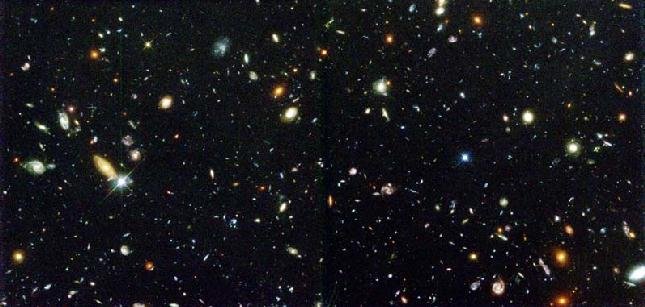
“Galaxies like colorful pieces of candy fill the Hubble Deep Field - humanity's most distant yet optical view of the Universe. The dimmest, some as faint as 30th magnitude (about four billion times fainter than stars visible to the unaided eye), are the most distant galaxies and represent what the Universe looked like in the extreme past, perhaps less than one billion years after the Big Bang. To make the Deep Field image, astronomers selected an uncluttered area of the sky in the constellation Ursa Major (the Big Bear) and pointed the Hubble Space Telescope at a single spot for 10 days accumulating and combining many separate exposures. With each additional exposure, fainter objects were revealed. The final result can be used to explore the mysteries of galaxy evolution and the infant Universe."
Copyright: Public domain
#602 The Gamma Ray Moon
Credit: February 10, 1997
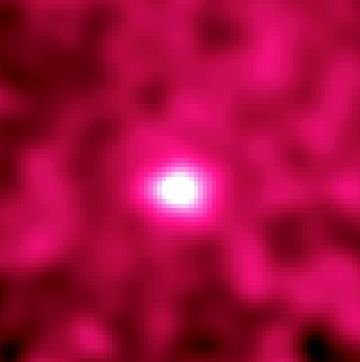
“What if you could see gamma rays (photons with more than 40 million times the energy of visible light)? If you could, the Moon would appear brighter than the Sun! This startling notion is demonstrated by this image of the Moon from the Energetic Gamma Ray Experiment Telescope (EGRET) onboard NASA's orbiting Compton Gamma Ray Observatory. The most sensitive instrument of its kind, even EGRET can not see the quiet Sun which is faint at extreme gamma-ray energies. Why is the Moon so bright in gamma rays? High energy charged particles known as cosmic rays, constantly bombard the unprotected lunar surface generating gamma rays. EGRET's gamma-ray vision is not sharp enough to resolve a lunar disk or any surface features but its sensitivity reveals the bright gamma-ray moonglow against a background of gamma rays from our Milky Way galaxy, gamma-ray quasars and some still mysterious unidentified sources. The image was generated from eight exposures made during 1991-1994. A wide-angle picture, it covers a roughly 40x40 degree field of view with gamma-ray intensity represented in false color."
Copyright: Public domain
#603 Space Walz
Credit: February 11, 1997
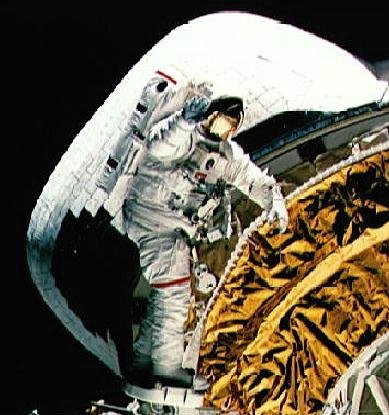
“Astronaut Carl Walz waves at his colleagues from the aft end of the Space Shuttle Discovery's payload bay - during a 1993 spacewalk to evaluate tools, tethers, and a foot restraint slated for use in the first Hubble Space Telescope servicing mission. Today's successful launch of Discovery begins the second servicing mission to the Hubble. Discovery's crew will rendezvous with the orbiting telescope and capture it with the shuttle's manipulator arm. With Hubble in the payload bay the crew will conduct spacewalks to replace two existing instruments with new ones. To be installed are the Space Telescope Imaging Spectrograph and the Near Infrared Camera and Multi-Object Spectrometer. Other hardware will also be replaced and upgraded including the telescope's Fine Guidance Sensor. The improved instrumentation will extend the Hubble's ability to explore the distant Universe."
Copyright: Public domain
#604 Comet Hale-Bopp Develops a Tail February 12, 1997
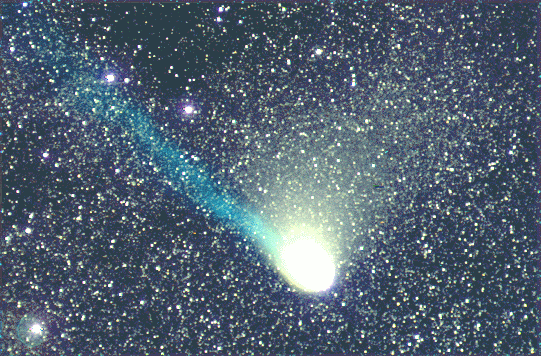
“Comet Hale-Bopp has quite a tail to tell already. This remarkable comet was first discovered in 1995, even before Comet Hyakutake. Since then, this erupting snowball continues to fall into our inner Solar System and is starting to put on quite a show. Comets have been known throughout history to show tails that spread across the sky. In the above picture, the blue stream is the ion tail which consists of ions pushed away from the comet's head by the solar wind. The ion tail always points directly away from the Sun. Comet Hale-Bopp is now visible in the morning sky, moving a few degrees each day. Comet Hale-Bopp is expected to be at its best and brightest in late March and early April. "
Copyright: Crni Vrh ObsU. Ljubljana
#605 More Jets From Comet Hale-Bopp
Credit: February 13, 1997
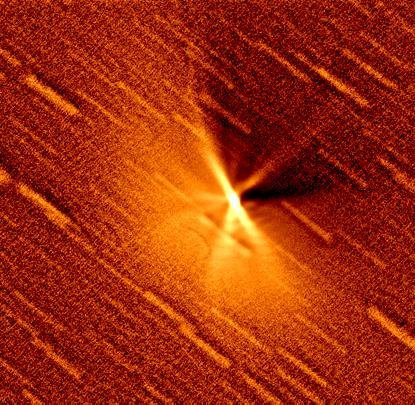
“Comets become fountains of gas and dust as they get near the Sun. Solar heat vaporizes the outer layers of these spectacular orbiting icebergs, exposing caverns of pressurized gas that erupt into jets. The above digitally enhanced image of Comet Hale-Bopp was taken on January 29th and highlights several of these dust jets. Here, background stars appear as faint raised streaks. Comet Hale-Bopp is currently brighter than most stars, and is visible in the morning sky. Comet Hale-Bopp will continue to brighten and develop an extended tail until April."
Copyright: Public domain
#606 NGC 1818: A Young Globular Cluster
Credit: February 14, 1997
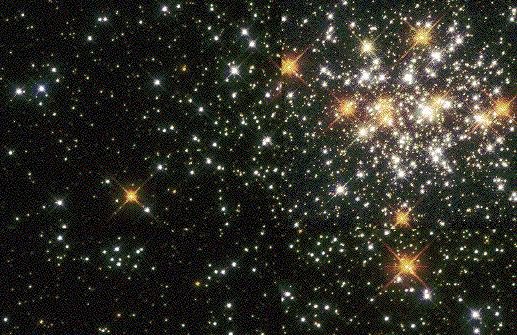
“Globular clusters once ruled the Milky Way. Back in the old days, back when our Galaxy first formed, perhaps thousands of globular clusters roamed our Galaxy. Today, there are perhaps 200 left. Many globular clusters were destroyed over the eons by repeated fateful encounters with each other or the Galactic center. Surviving relics are older than any earth fossil, older than any other structures in our Galaxy, and limit the universe itself in raw age. There are few, if any, young globular clusters in our Milky Way Galaxy because conditions are not ripe for more to form. But things are different next door - in the neighboring LMC galaxy. Pictured above is a "young" globular cluster residing there: NGC 1818. Recent observations show it formed only about 40 million years ago - just yesterday compared to the 12 billion year ages of globular clusters in our own Milky Way"
Copyright: Public domain
#607 Shapley 1: An Annular Planetary Nebula
Credit and Copyright: February 15, 1997
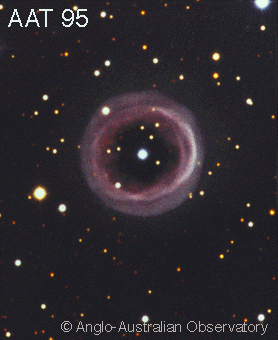
“What happens when a star runs out of nuclear fuel? The center condenses into a white dwarf while the outer atmospheric layers are expelled into space and appear as a planetary nebula. This particular planetary nebula, designated Shapley 1 after the famous astronomer Harlow Shapley, has a very apparent annular ring like structure. Although some of these nebula appear like planets on the sky (hence their name), they actually surround stars far outside our Solar System. "
Copyright: Public domain
#608 Betelgeuse, Betelgeuse, Betelgeuse
Credit: February 16, 1997

“Betelgeuse (sounds a lot like "beetle juice"), a red supergiant star about 600 light years distant, is seen in this Hubble Space Telescope image -- the first direct picture of the surface of a star other than the Sun. A bright, as yet unexplained hotspot is revealed on its surface! While Betelgeuse is cooler than the Sun, it is more massive and over 1000 times larger. If placed at the center of our Solar System, it would extend past the orbit of Jupiter. Betelgeuse is also known as Alpha Orionis, one of the brightest stars in the familar constellation of Orion, the Hunter. Like many star names, Betelgeuse is Arabic in origin. It is derived from a phrase which refers to the hunter's shoulder or armpit, the general area occupied by this star in drawings of the figure in the constellation. As a massive red supergiant, it is nearing the end of its life and will soon become a supernova."
Copyright: Public domain
Upvote! Resteem! Comment! As you like it! Thank you for attention!
Resteemed to over 5700 followers and 100% upvoted. Thank you for using my service!
Send 0.100 Steem or 0.100 Steem Dollar and the URL in the memo to use the bot.
Read here how the bot from Berlin works.
@resteem.bot
I have upvoted you, please upvote me and follow too
Thanks for upvoting friends! We continue the journey to the stars!